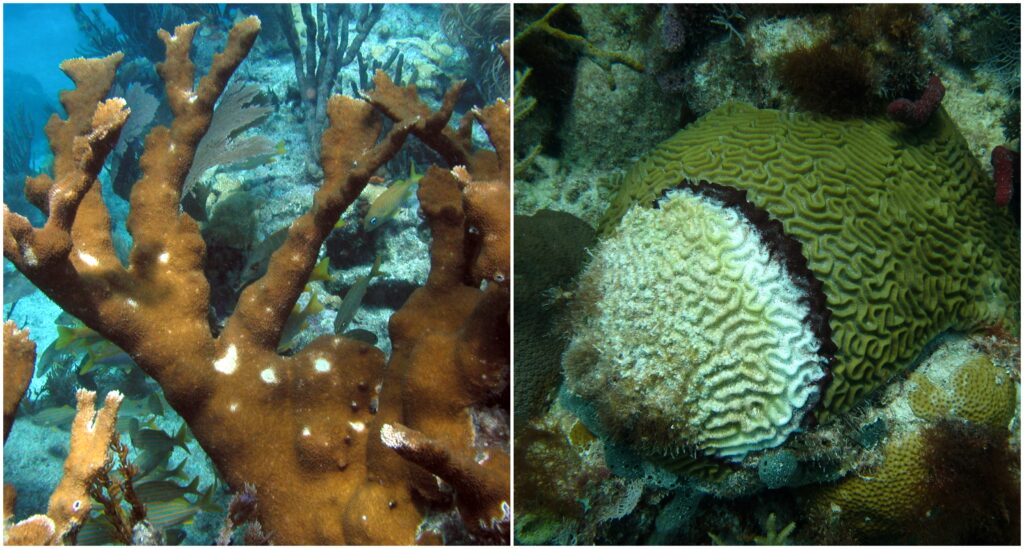Impacts on Marine Life
Impacts from wastewater pollution have detrimental effects on human health and marine life. Wastewater transports pathogens, nutrients, contaminants, and solids into the ocean that can cause coral bleaching and disease and mortality for coral, fish, and shellfish. Wastewater pollution can also alter ocean temperature, pH, salinity, and oxygen levels, disrupting biological processes and physical environments essential to marine life.
Pathogens
Wastewater pollution increases corals’ exposure to disease-causing viruses, bacteria, or other microorganisms, collectively known as pathogens. Outbreaks of two of the most common coral diseases, white pox and black band disease, have been linked to wastewater pollution. White pox is directly caused by the human gut pathogen Serratia marcescens, while black band disease is strongly associated with macroalgal cover that increases in polluted waters. Pathogens can also harm invertebrates including shellfish, as they also take in pathogens and other pollutants as they filter ocean water.

Left: Elkhorn coral with white pox. Photo © James Porter/National Science Foundation. Right: Symmetrical brain coral with black band disease. Photo © Christina Kellogg/USGS
Nutrients
Nutrients are essential building blocks for marine life. However, excess nutrients from land-based sources of pollution—like agricultural runoff and wastewater—in the marine environment cause coral bleaching and disease, decreased coral reproductivity, decreased coral skeletal integrity, decreased coral cover and biodiversity, increased phytoplankton shading, and algal overgrowth. ref Nutrients can also harm other marine invertebrates, including shellfish that filter nutrients from the water for shell and tissue formation leading to declines in shellfish health. Ongoing nutrient loading can lead to algal blooms, which can devastate coral reefs and coastal ecosystems and are predicted to increase in frequency and scale as a result of climate change.
Algal blooms consume oxygen and block sunlight that underwater plants need to produce oxygen, resulting in an environment with low levels of dissolved oxygen called hypoxia. As oxygen is depleted, fish and crabs will move away. Hypoxic environments can trigger coral bleaching events, leading to increased damage and decreased recovery capacity of corals. These oxygen-depleted environments are projected to increase in frequency and severity with climate change.

Marine life responses to mild and severe hypoxia, including changes in physiological processes, habitat choices, and survivorship. Note: BBD stands for black band disease. Source: Nelson and Altieri 2019
Solids
Wastewater also contains suspended solid materials—like decomposing plant matter, algae, minerals, and silt—that float in the water. In the ocean, solids:
- Block sunlight, which can result in decreased photosynthesis and coral growth.
- Cause physical stress including smothering, decreased food production, and reduced reproduction of corals.
- Clog filters of shellfish as suspended particles are ingested.
- Decrease water clarity disrupting reproduction and making it harder for fish to find food.
Contaminants
Contaminants in wastewater can affect corals in various ways at multiple life stages. ref Herbicides damage symbiotic algae in coral, affecting photosynthesis and causing bleaching. Metals and synthetic compounds like polychlorinated biphenyls (PCBs) have a toxic effect on corals and other marine life including fishes disrupting several processes at multiple life stages. ref In corals, they impact reproduction, feeding, and growth, which then reduces habitat options for other organisms. In fish, they accumulate through the food web and increase mortality rates in larger fish. Pharmaceuticals can also have behavioral and health impacts on fish. Research on this broad category of pollutants has only recently begun and much more is needed to define the contaminants and their impacts.
Endocrine Disruptors
Endocrine disruptors—compounds which impact the endocrine system—are a particularly concerning type of CEC. These include naturally occurring or synthetic hormones as well as chemicals produced for textile, plastic, household, or agricultural uses. Research has begun to show the ways that these pollutants cause harm to marine life:
- In low concentrations, antidepressants have been shown to impact fish behavior and cause mortality.
- Synthetic hormones and endocrine disruptors—like estrogen from birth control pills or parabens found in soaps—can impair reproductivity and contribute to aggressive tendencies in fish.
- Recent studies have identified endocrine disruptors that bioaccumulate in fish tissue.
- In corals, endocrine disruptors decrease the number of egg-sperm bundles and reduce growth rates.

